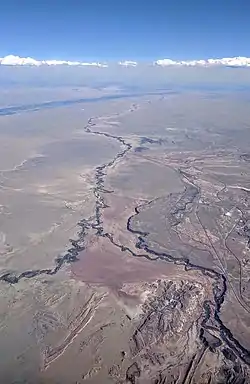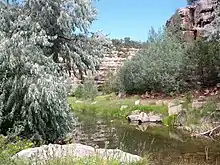| Rio San Jose | |
|---|---|
 Aerial view from west of Albuquerque of the last few miles of the Rio San Jose (bottom right) as it merges with the Rio Puerco, which flows to the Rio Grande in the distance | |
 Map of the Rio Grande watershed, showing the Rio San Jose joining the Rio Puerco near Albuquerque | |
| Location | |
| Country | United States |
| State | New Mexico |
| County | Cibola, Valencia, Bernalillo |
| Physical characteristics | |
| Source | Zuni Mountains |
| • location | Bluewater Village, Valencia County |
| • coordinates | 35°17′14″N 107°59′58″W / 35.28722°N 107.99944°W |
| • elevation | 6,651 ft (2,027 m) |
| Mouth | Rio Puerco |
• location | near Isleta Pueblo, Bernalillo County |
• coordinates | 34°52′50″N 107°01′40″W / 34.88056°N 107.02778°W[1] |
• elevation | 5,102 ft (1,555 m)[1] |
| Length | 90 mi (140 km)[2] |
| Basin size | 2,597 sq mi (6,730 km2)[3] |
The Rio San Jose is a 90-mile-long (145 km) tributary of the Rio Puerco in the U.S. state of New Mexico.
Course

The Rio San Jose's farthest tributary stream is Bluewater Creek; its headwaters are in the Zuni Mountains, near the continental divide in Cibola County, with about 400 feet of the course in McKinley County. Bluewater Creek is dammed to form Bluewater Lake, with a capacity of 43,500 acre-feet (53,700,000 m3).[4] The Rio San Jose proper starts at the confluence of Bluewater Creek and Mitchell Draw near Bluewater Village. Entering Valencia County, it flows southeast, through Grants, then turning east near McCartys, flowing through the Acoma Indian Reservation and Laguna Pueblo. The remains of an ancient dam constructed by the Laguna people sometime between 1370–1750 AD is situated within Laguna Pueblo.[5] Below Mesita the river turns southeast again, flowing through a narrow canyon before joining the Rio Puerco in Bernalillo County.
The entire course of the river below Bluewater Creek is roughly paralleled by the BNSF Railway tracks (formerly the Atlantic and Pacific Railroad, built around 1882, later absorbed into the AT&SF). Between Bluewater Village and Mesita the river valley provides the route for old U.S. Route 66 and I-40.
Hydrology
The water level and streamflow of the Rio San Jose has been measured at a number of sites in Cibola County, New Mexico. Stream gauges have been operated by the USGS near Laguna, Correo, and at Acoma Pueblo, near Grants.[6][7][8]
The gauge at Acoma Pueblo has a record that commenced in 1937, and is the only one still active. It measures flow from a contributing area of 1,170 square miles (3,000 km2), from a larger drainage basin of 2,300 square miles (6,000 km2). The mean flow between 1937 and 2016 was 6 cubic feet per second (0.17 m3/s), with the lowest daily flow recorded in July 2014 at 1.3 cubic feet per second (0.037 m3/s).[6]
The highest river level recorded occurred in September 1963 with a height of 4.87 feet (1.48 m) through the gauge, giving a corresponding flow of 1,400 cubic feet per second (40 m3/s), although this peak flow was affected by diversion or regulation.[6]
Since the 1870s the flow of the upper river has been substantially modified by demands for irrigation, groundwater abstraction and a dam on the Bluewater Creek. A report in 1982 showed that the natural flow was estimated to be between 16.6 cubic feet per second (0.47 m3/s) and 19.3 cubic feet per second (0.55 m3/s), as opposed to the measured mean flow of 6.7 cubic feet per second (0.19 m3/s).[2]
See also
References
- 1 2 U.S. Geological Survey Geographic Names Information System: RioSan Jose
- 1 2 Risser, Dennis (1982). "Estimated Natural Streamflow in the Rio San Jose Upstream from the Pueblos Of Acoma And Lacuna, New Mexico". U.S. Geological Survey. Retrieved 10 July 2018.
- ↑ "National Hydrography Dataset via National Map Viewer". U.S. Geological Survey. Retrieved 2018-07-14.
- ↑ "Bluewater Lake State Park". New Mexico State Parks. Retrieved 2018-07-14.
- ↑ Gary Huckleberry , T.J. Ferguson , Tammy M. Rittenour , Chris Banet , and Shannon Mahan (2016). "Identification and dating of indigenous water storage reservoirs along the Rio San José at Laguna Pueblo, western New Mexico, USA". Journal of Arid Environments. U.S. Geologic Survey. Retrieved 2018-07-14.
{{cite web}}: CS1 maint: multiple names: authors list (link) - 1 2 3 "USGS 08343500 RIO SAN JOSE – Summary Statistics". National Water Information System. U.S. Geological Survey. Retrieved 10 July 2018.
- ↑ "USGS 08350500 Rio San Jose near Laguna, NM". National Water Information System. U.S. Geological Survey. Retrieved 10 July 2018.
- ↑ "08351500 Rio San Jose at Correo, NM". National Water Information System. U.S. Geological Survey. Retrieved 10 July 2018.